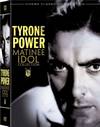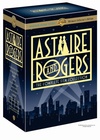


Errol Flynn & Olivia de Havilland
Filmography | Articles | Awards | Downloads | Bibliography | Links | Image Credits | Errol Flynn | Olivia de Havilland
| Article 7 |
'Santa Fe Trail,' Which Is Chiefly a Picture About Something Else, Opens at the Strandby Bosley CrowtherNew York Times December 21, 1940, page 23The most significant comment one can make about the Warners' rowdy-dowdy "Santa Fe Trail," which arrived yesterday at the Strand, is that the action of it never reaches Santa Fe -- never, as a matter of fact, even comes anywhere near that terminal point. Somewhere about the middle of the picture -- in the smoke of screaming battle, perhaps, or in the dark of a Kansas night -- it misses the trail entirely, turns eastward instead of southwest and arrives at a destination quite remove from that for which it apparently started out. As the biggest non-sequitur of the season, from the directional, historical and titular point of view, we give you "Santa Fe Trail." Don't get us wrong. We aren't saying that it lacks what is known as mass appeal. As in previous Warner epics of the building, etc. of the American West, it has about everything that a high-priced horse-opera should have -- hard riding, hard shooting, hard fighting, a bit of hard drinking and Errol Flynn. It touches sketchily upon the pre-Civil War struggle between slaveholders and abolitionists in Kansas Territory, thereby acquiring a note of profundity. It is very solemn about manifest destiny. Alan Hale and Guinn (Big Boy) Williams roll through it as a couple of lusty frontier comics, as usual. The United States Cavalry comes whooping to the rescue not once but twice -- and beautifully. Yet for any one who has the slightest regard for the spirit -- not the mention the facts -- of American history, it will prove exceedingly annoying. For, without the least hesitation, the Warners have blithely enrolled Jeb Stuart, George Custer, Phil Sheridan, James Longstreet, George Pickett and John B. Hood in the Class of 1954 at West Point; has graduated them en masse to Kansas, like a troop of adventure-loving Rover Boys, and has there put them to guarding the perilous trail to Santa Fe. But very soon, Jeb and the boys run afoul of John (Osawatomie) Brown, the abolitionist leader, and from then on it is Jeb and his Young Generals versus old Osawatomie and his villainous band all the way from Fort Leavenworth, Kan., to the final kill at Harpers Ferry, Va. It is a noisy and bloody pursuit. Now, the judgment of history upon John Brown is divided, it is true. Some hold that he was a great martyr to the cause of freeing the slaves, others suspect he was just a wild fanatic driven mad by a high ideal. But he was hardly the crack-pot villain that the Warners have broadly implied, and he deserves a better classification in the minds of impressionable movie-goers than that just one peg above a marauding cattle rustler from Bloody Gulch. Still, the story demanded a bad man for Mr. Flynn and his laddies to chase, so John Brown turns out it. On another less serious count, the Warners may be charged with abandoning fact for the sake of expediency. Mr. Flynn plays Jeb Stuart, who was famous for his flowing red beard, with but the trace of a moustache on his lip. A shorn and fragile Jeb, one may complain; yet think what the fans would say if Mr. Flynn had to play a romantic role behind a mess of herbage! However, Raymond Massey, as John Brown, makes up in hirsute adornment what Mr. Flynn lacks -- and in vigorous authority, too. Mr. Massey's Brown, though mad, is a very commanding person. In fact, he is the most convincing leader in the film. Next to his, Van Heflin's performance as a treacherous follower contains the sharpest punch. The rest are all routine. Incidentally, we would like to know what happened to that strange railroad we saw building in just one shot. Did it ever reach Santa Fe? © 1940 New York Times |
Return to the Index of Articles. |
| Current Contest Prize: |
|---|
| Now in Print! |
|---|
| Now on DVD! |
|---|
Buy Videos & DVDs |
|
Buy Movie Posters |
|
Buy Movie Posters |
|
Classic
Movie Merchandise |
|
![]() Printer-friendly version.
Printer-friendly version.
![]() Return
to the top.
Return
to the top.
Last updated:
December 16, 2008.
Reel Classics is a registered trademark of Reel Classics, L.L.C.
© 1997-2009 Reel Classics, L.L.C. All rights reserved. No
copyright is claimed on non-original or licensed material.
Terms of
Use.










